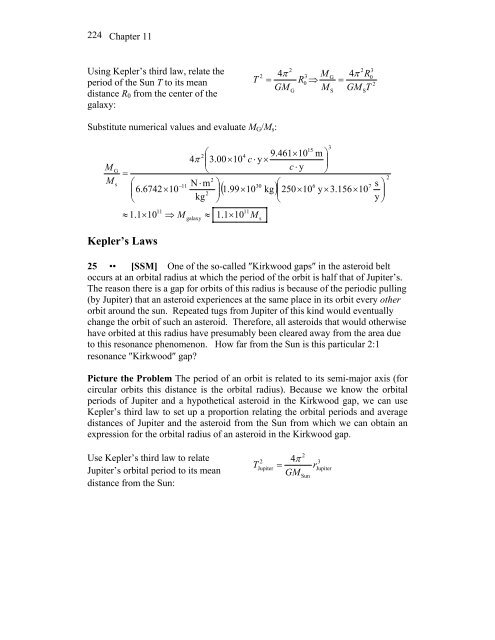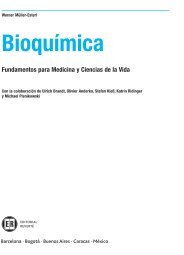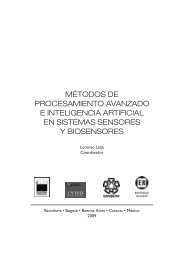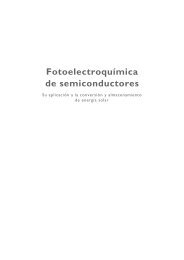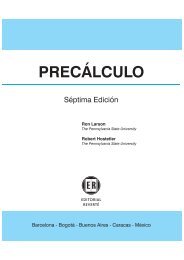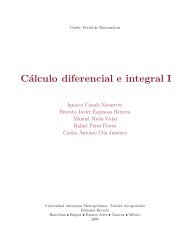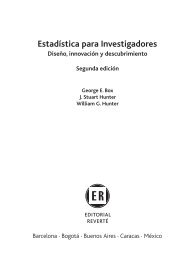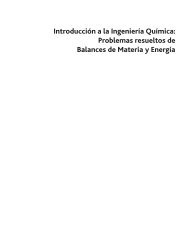Chapter 11 Gravity
Chapter 11 Gravity
Chapter 11 Gravity
You also want an ePaper? Increase the reach of your titles
YUMPU automatically turns print PDFs into web optimized ePapers that Google loves.
224<br />
<strong>Chapter</strong> <strong>11</strong><br />
Using Kepler’s third law, relate the<br />
period of the Sun T to its mean<br />
distance R0 from the center of the<br />
galaxy:<br />
Substitute numerical values and evaluate MG/Ms:<br />
M<br />
M<br />
G<br />
s<br />
galaxy<br />
T<br />
4π<br />
M 4π<br />
R<br />
2<br />
2 3<br />
2<br />
=<br />
GM G<br />
3 G R0<br />
⇒<br />
M S<br />
0 =<br />
2<br />
GM ST<br />
15<br />
2⎛<br />
4 9.<br />
461×<br />
10 m ⎞<br />
4π<br />
⎜<br />
⎜3.00×<br />
10 c ⋅ y×<br />
c y ⎟<br />
⎝<br />
⋅<br />
=<br />
⎠<br />
2<br />
⎛ −<strong>11</strong><br />
N ⋅ m ⎞<br />
30 ⎛<br />
6<br />
⎜<br />
⎜6.<br />
6742×<br />
10 ( 1.<br />
99×<br />
10 kg)<br />
⎜250×<br />
10 y×<br />
3.<br />
156×<br />
10<br />
2<br />
kg ⎟<br />
⎝<br />
⎠<br />
⎝<br />
<strong>11</strong><br />
≈ 1.<br />
1×<br />
10 ⇒ M ≈<br />
<strong>11</strong><br />
1.<br />
1×<br />
10 M<br />
Kepler’s Laws<br />
25 •• [SSM] One of the so-called ″Kirkwood gaps″ in the asteroid belt<br />
occurs at an orbital radius at which the period of the orbit is half that of Jupiter’s.<br />
The reason there is a gap for orbits of this radius is because of the periodic pulling<br />
(by Jupiter) that an asteroid experiences at the same place in its orbit every other<br />
orbit around the sun. Repeated tugs from Jupiter of this kind would eventually<br />
change the orbit of such an asteroid. Therefore, all asteroids that would otherwise<br />
have orbited at this radius have presumably been cleared away from the area due<br />
to this resonance phenomenon. How far from the Sun is this particular 2:1<br />
resonance ″Kirkwood″ gap?<br />
Picture the Problem The period of an orbit is related to its semi-major axis (for<br />
circular orbits this distance is the orbital radius). Because we know the orbital<br />
periods of Jupiter and a hypothetical asteroid in the Kirkwood gap, we can use<br />
Kepler’s third law to set up a proportion relating the orbital periods and average<br />
distances of Jupiter and the asteroid from the Sun from which we can obtain an<br />
expression for the orbital radius of an asteroid in the Kirkwood gap.<br />
Use Kepler’s third law to relate<br />
Jupiter’s orbital period to its mean<br />
distance from the Sun:<br />
T<br />
s<br />
2<br />
Jupiter<br />
2<br />
4π<br />
=<br />
GM<br />
Sun<br />
r<br />
3<br />
3<br />
Jupiter<br />
7<br />
s<br />
y<br />
⎞<br />
⎟<br />
⎠<br />
2


